I visited the Department of Aero and Auto Engineering at Loughborough University yesterday to meet up with my old friend and collaborator Prof Rui Chen. Rui and I discussed collaborating on some upcoming EU Horizon 2020 calls, and also further collaborative work on our 4-stroke free piston hybrid generator. More info on the Engine development […]
Prof Rui Chen
MAAT EU FP7 Advanced Airship who’s who? – University of Modena and Reggio Emilia
The EU FP7 project – MAAT Multibody Advanced Airship for Transport kicks off on 1st September 2011. Here are some of the participants in the project, starting with the Project Leaders and Grant Co-Ordinators at the University of Modena in Italy:
Organization: University of Modena and Reggio Emilia – Department of Sciences and Methods of Engineering (Di.S.M.I.) Short name: UNIMORE
General Description
The university of Modena and Reggio Emilia is separate among two academic poles. From 1998, the universities in Modena and Reggio Emilia are united in an only Athenaeum that has Faculties in Modena (Bioscience and Biotechnology, Economy, Pharmacy, Jurisprudence, Engineering…) and in Reggio Emilia (Agriculture, Engi- neering, Sciences of the Communication and the economy…). In Reggio Emilia there is the Department of Sci- ence and Engineering Methods (DISMI). The DISMI conducts research, training and technology transfer in en- gineering and basic disciplines that support them. In particular, the researchers of the DISMI are specialized in Engineering Management, Mechatronic Engineering and Energy, in an integrated and interdisciplinary approach that includes all subjects of basic sciences.
Main related expertises:
Antonio Dumas, full professor of Technical Physics of the course of Degree of Managerial Engineering of the Faculty of Engineering to the University of Modena and Reggio Emilia. His studies are directed in the field of thermal exchange and thermo-fluid dynamic. He researches on problems related to solar energy, energetic econ- omy, devices of measure and analysis of data, fundamental phenomena of thermo-fluid dynamic, Solar energy. Related publications):
A. Dumas, S. Anzillotti, M. Trancossi, Zumbo F.: photovoltaic stratospheric isle for conversion in hydrogen as energy vector: energetic and economic feasibility analysis – Proceedings of Second Energy Management Confer- ence (AIGE), 2008; Pages: 4 – 10; ISBN: 978-88-6261-088-9 A. Dumas, s. Anzillotti – PSICHE: A Stratospheric Platform Producing Hydrogen and Oxygen – Proceedings of 5th International Conference on Sustainable Energy Technologies, Vicenza 2006; Pages: 471 – 476; ISBN: 88- 89884-05-3
Bianca Rimini, full professor in Mechanical Industrial Plants at the Faculty of Engineering of Reggio Emilia. She has a large experience in the field of industrial plants, logistics and production systems. The results of her researches are published in many scientific and technical journals and in many papers presented at National and International Conferences. Related publications:
Gamberini R., Gebennini E., B. Rimini (2009). An innovative container for WEEE collection and transport: de- tails and effect following the adoption. waste management, vol. 29; p. 2846-2858, ISSN: 0956-053X Gebennini E, Dallari S, Perrica G, A. Grassy, Rimini B., Fantuzzi C. (2009). Adoption of control policies in a simulative model for the design of AGV systems. In: Proceedings of the Spring Simulation Multiconference 2009. San Diego, CA, USA, March 22-27, 2009, SAN DIEGO, CA: The Society for Modelling and Simulation International, p. 124-129, ISBN/ISSN: 1-56555-327-6
Eugenio Dragoni, full Professor of Mechanical Engineering Design to the University of Modena and Reggio Emilia, and was appointed head of the Department of Sciences and Methods for Engineering. He has authored or co-authored more than 100 papers on a variety of subjects including computational mechanics, mechanical be- haviour of adhesives and non-metals, engineering applications of smart materials, product design and develop-ment.
Related publications:
M. Benetti, E. Dragoni, D. Castagnetti, E.J. v.d. Heide (2003) “Development and testing of an inflatable capsule for the YES2 project”, 55th International Astronautical Congress, Vancouver, Canada.
The Lotus Free Piston Engine project story – people2
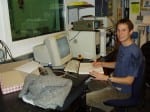
Simon Wilson was in one of my 4th year MEng project groups at Sheffield Uni, and stayed on to read for a PhD with me on Temperature Estimation for Permanent Magnet AC Motors. Simon received an Industrial CASE award from Rolls-Royce Derby for the duration of his study. He can be seen here setting up the DSpace controller which supervises data acquisition and control for the engine.
Simon has subsequently joined EA Technology at Capenhurst as a consultant on new renewables technology.
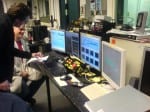
Next up is Ed Winward, who was working for Professor Rui Chen at Loughborough University. Ed designed and implemented the entire front-end for the free piston project in Labview (see picture left) which allowed us to start experimentation in earnest.
The best tribute to his part in this project is a YouTube video he made which documents an early run of the Free-Piston Engine
The Lotus Free Piston Engine project story – people

After delivery to the engine test cells at Loughborough University AAE dept., it took a significant amount of time to put together the control system instrumentation, and the control architectures necessary to run the engine under Labview, and DSpace.
This part of the story is the people behind developing this part of the project.
First up is Dr Ben Taylor, who at the time was one of my Post-Doctoral researchers at the University of Sheffield Department of Electronic and Electrical Engineering, and is currently a Research Fellow there in the Department of Automatic Control and Systems Engineering. Ben designed and built the 100kW four-quadrant power converter which in the early stages of the project drove the permanent magnet servo-motor attached to the end of the tethering crankshaft. This arrangement allowed us to make the initial development happen relatively safely, without the danger of losing control and blowing up the engine. Later developments are untethered from the crankshaft and truly ‘Free-Piston’
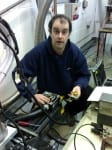
Ben also designed the control system for the servo-motor, based around a TI Digital Signal Processor (DSP) which allowed accurate, real-time control of the motor currents, and position/velocity control of the motor, interfaced to a DSpace real-time controller.
Ben subsequently moved on to work for myself and Prof Chris Bingham on a RDA funded project on intelligent heating controls and methods for domestic houses.
The power converter which Ben designed and built is now in use driving the linear electrical machine embedded in the engine, whilst the drive of the crankshaft servo-motor has been take over by a custom designed four-quadrant inverter designed and installed by Control Techniques


The Lotus Free Piston Engine project story part I
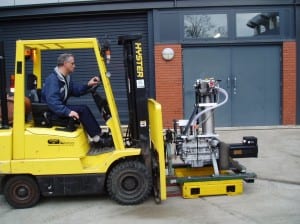
The idea to develop a free piston engine has a long history, mainly focusing on two-stroke designs with a combustion chamber at each end of a linear motor generator. the main idea is to remove the physical constraints imposed by conventional crankshaft based engines, reduce the mechanical losses to improve the engine efficiency, and to introduce elements of piston trajectory control to allow advanced combustion control.
As if that wasn’t challenging enough, Jamie Turner of Lotus Engineering and I had the idea of pushing the envelope even further, to create a single combustion chamber, four-stroke design. This developed from the fact that two-ended designs are generally constrained to operate via an oscillating principle akin to simple harmonic motion for increase efficiency. In our view, we wanted to push the technology of the possible even further, and design what was originally called the Lotus Active Crank Train (ACT) and eventually became the Zero Constraint Free Piston Energy Converter.
We originally applied to the EPSRC ‘Adventure Fund’, but the application was rejected on the grounds that the proposal was ‘too adventurous’! The EPSRC however invited us to re-submit, and the project became…
EPSRC Grant: GR/S97507/01 ‘Zero Constraint Free Piston Energy Converter‘
PI: Paul Stewart. Co-Investigator: D. Howe. (University of Sheffield) Collaborating University: Dr Rui Chen, Dept. Aeronautical and Automotive Engineering, University of Loughborough UK. Collaborating Company: Lotus Engineering, Consortium Project Manager: Paul Stewart.
P. Stewart: £326,00, R. Chen £260,000, Lotus Engineering Contribution: £330,000
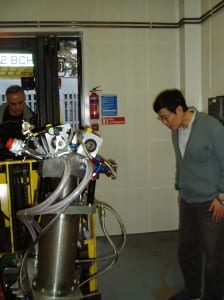
I was a Junior Lecturer at the time in the Electrical Machines and Drives Group at Sheffield University. I needed an engines/combustion collaborator, and since I had worked at Loughborough as a Post-doc, searched their web-site and approached Dr Rui Chen who was then also a Junior Lecturer (now Professor of Low Carbon Power Engineering) in the Department of Aeronautical and Automotive Engineering at the University of Loughborough. This was the start of a research relationship and friendship which lasts to this day.
In order to ‘de-risk’ the project, the free-piston was originally tethered to the crankshaft of a General Motors 1.8l engine so that we could conduct our initial development in relative safety. The engine as delivered from lotus is pictured above, the free-piston part (nick named the ‘rocket launcher’) is the tube and cylinder head sticking up from the GM crankcase. In the next part of the story, we get it running, and discover we can look at some hitherto unattainable fundamental aspects of combustion.